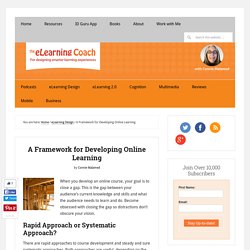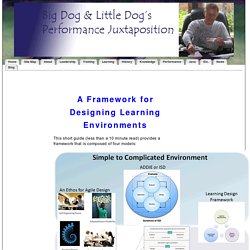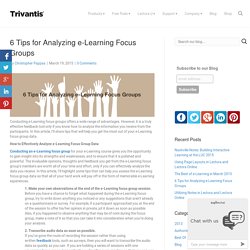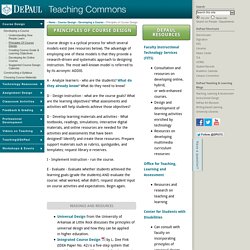

A Framework for Developing Online Learning. SumoMe When you develop an online course, your goal is to close a gap.

This is the gap between your audience’s current knowledge and skills and what the audience needs to learn and do. Become obsessed with closing the gap so distractions don’t obscure your vision. Rapid Approach or Systematic Approach? There are rapid approaches to course development and steady and sure systematic approaches. Instructional Design Professionals in the field of eLearning typically use a framework known as Instructional Design (ID) for developing all types of instructional materials. ADDIE vs AGILE: How to set up a fast and effective eLearning production process.
Steve Penfold | Posted on April 21, 2016 in Course Content, Success | No Comments This guest post is by Steve Penfold, Customer Success Director at Elucidat.

The best production process isn’t the one that gets course content before an audience as quickly as possible. The best process is the one that can reliably deliver high quality learning content that’s fit for purpose to an audience within an appropriate timeframe. According to the Project Management Institute, ineffective communication is the primary contributor to project failure one third of the time. And 55% of project managers agree that effective communication to all stakeholders is the most critical success factor in project management. 1. ADDIE has been around since the 1950s. Analysis This initial fact-finding phase allows you to define your project and get buy-in and collaboration from all stakeholders. Who is the target audience?
ADDIE Model Explained. Anyone who is actively involved with instructional design has at some point used the ADDIE model (Analyze, Design, Develop, Implement, and Evaluate) for their course development.

This model is one of (if not the) most popular structures used by training designers today. As you can expect, it has received a lot of attention from the community – some criticizing it, others providing praise. Personally, I feel that ADDIE works just fine, and I have used a variation of it for years on my own projects. It’s actually quite interesting how passionate people are one way or another when it comes to this model. I think if you approach any training design and implementation with an understanding that it will have its own unique qualities, then you allow for a flexibility within the model road-map.
How to use the Kirkpatrick Model of evaluation with e-learning. How to Measure the Effectiveness of Your Online Course - E-Learning Heroes. How to Measure the Satisfaction of Learners Taking Your Online Courses - E-Learning Heroes. The Death of ADDIE? In a recently received email solicitation for ASTD (American Society for Training and Development) membership, they are offering a free copy of Michael Allen’s new book Leaving ADDIE for SAM.

Like many practicing trainers who also design and develop training material, I’ve used the ADDIE model my entire career to facilitate the process. ADDIE, if you aren’t familiar, is an acronym for the steps in this universally accepted instructional design process standing for Analysis, Design, Development, Implementation, and Evaluation. This process, when used properly, is a key to success in instructional design. So, being intrigued by this concept of replacing ADDIE with another model, I did some research on the new model – SAM – which stands for Successive Approximation Model. I came across a few articles and blogs which helped explain things to me. This article is from Allen Interactions, Mr. Instructional System Design. This short guide (less than a 10 minute read) provides a framework that is composed of four models: While you can click any part of the above map (to include the Complex/Complicated Environments) to learn more about the topic, it is suggested you read the following first to see how the various models tie together.

Instructional System Design — This guide to ISD uses the ADDIE model (analysis, design, develop, implement or delivery, & evaluation). A Hard Look at ISD. In the February 2002 edition of Training magazine Ron Zemke and Allison Rossett wrote a follow up to The Attack on ISD with A Hard Look at ISD.

In their opening section, they write, Many of the affronted challenged the magazine's right to make the critique it did and chose to berate both the authors and the experts whose views were cited. The ADDIE Analysis Phase. 6 Tips for Analyzing e-Learning Focus Groups. Conducting e-Learning focus groups offers a wide range of advantages.

However, it is a truly effective feedback tool only if you know how to analyze the information you receive from the participants. In this article, I’ll share tips that will help you get the most out of your e-Learning focus group data. How to Effectively Analyze e-Learning Focus Group Data Conducting an e-Learning focus group for your e-Learning course gives you the opportunity to gain insight into its strengths and weaknesses, and to ensure that it is polished and powerful. The invaluable opinions, thoughts and feedback you get from the e-Learning focus group’s members are worth all of your time and effort, only if you can effectively analyze the data you receive. 1. 2. 3. 4.
Principles of Course Design - Teaching Commons. Course design is a cyclical process for which several models exist (see resources below).

A.D.D.I.E Model - Click4it. The PDR Learning Continuum – Using a New Design Framework. Many of us cut our professional learning design teeth using the long-held tradition of the Analyze, Design, Develop, Implement, Evaluate (ADDIE) instructional design (ISD) model.

Trolling many of the learning oriented groups in our blogosphere, I have heard numerous times how “old school”, and in some cases, how obsolete this foundational design model from the 1960s has become. If age denotes obsolescence, then yours truly is in trouble for sure. On the other hand, obsolescence can be averted when there is a willingness to change, a willingness to re-think and re-apply proven methodologies that are baked into the model of our choice. With that open-minded mentality, I confess to listening to the debates and witnessing the momentum to pile on, and it causes me to wonder, “Is the ADDIE model really falling short?” Methinks that it may very well be our application of the model that is falling short and worthy of re-examination. Figure 1.0 Figure 1.1 Figure 1.2. Instructional Design Models and Methods. Instructional Design Models and Methods "Models, like myths and metaphors, help us to make sense of our world.

Whether derived from whim or from serious research, a model offers its user a means of comprehending an otherwise incomprehensible problem. An instructional design model gives structure and meaning to an I.D. problem, enabling the would-be designer to negotiate her design task with a semblance of conscious understanding.